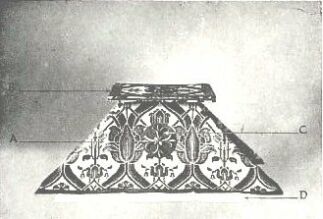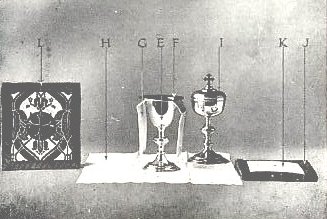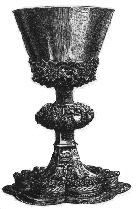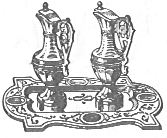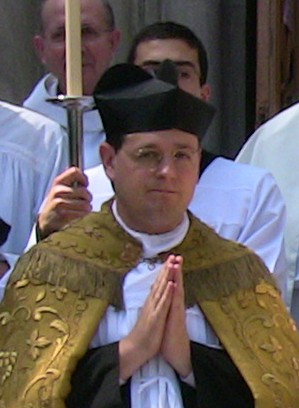Random Thoughts
Not Enough Time!!!!
St. Anthony Catholic Church
The Architecture
Stylistically, St. Anthony’s is a late Victorian Era design that makes sound use of the round, or Roman arch.
Such feature is of substantial historical importance, for it carries on the significant German Heritage of this Parish: this house of worship’s architectural spirit is that of the German Romanesque - a fusion of essential Gothicism with Romanesque forms that were somewhat peculiar to Northern Europe.
Construction of the exterior brick walls is expertly carried out and serves as a model for the brick mason’s art. Also notable is the eclectic wooden steeple/tower centered on the front with its Moorish design implications: perhaps this feature is meant to represent the faith’s universality.
It is realistically assumed that the Franciscan Order, when hiring Louis Piket, the Church architect, chose a designer who; had familiarity with the history of European Church architecture - especially with the Romanesque mode as interpreted in Germany. thus, continuity of regional and ethnical/national heritage was felt appropriate for the Parish of St. Anthony Church by is designer.
From John Senior's "The Restoration of Christian Culture"
Whatever we do in the political and social order, the indispensable foundation is prayer, the heart of which is the Holy Sacrifice of the Mass, the perfect prayer of Christ himself, Priest and Victim, revealing in an unbloody manner the bloody selfsame Sacrifice of Calvary.What is Christian Culture? It is essentially the Mass.That is not my or anyone's opinion or theory or wish but the central fact of two thousand years of history. Christendom, what secularists call Western Civilization, is the Mass and the paraphenalia which protect and facilitate it. All architecture, art, political and social forms, economics, the way people live and feel and think, music, literature- all these things, when they are right, are ways of fostering and protecting the Holy Sacrifice of the Mass.
To enact a sacrifice, there must be an altar, an altar has to have a roof over it in case it rains; to reserve the Blessed Sacrament, we build a little House of Gold and over it a Tower of Ivory with a bell and a garden round about with roses and lilies of purity, emblems of the Virgin Mary- Rosa Mystica, Turris Davidica, Turris Eburnea, Domus Aurea- who carried his Body and His blood in her womb, Body of her body, Blood of her blood. And around the Church and garden, where we bury the faithful dead, the caretakers live, the priests and religous whose work is prayer, who keep the Mystery of Faith in its tabernacle of music and words in the Office of the Church; and around them the faithful who gather to worship and divide the other work that must be done in order to make the perpetuation of the Sacrifice possible - to raise the food and make the clothes and build and keep the peace so that generations to come may live for Him, so that the Sacrifice goes on even until the consummation of the world.
From John Senior's "The Restoration of Christian Culture"
Early Nano Technology
from Nanite News @ nanitenews.com
Stained glass windows that are painted with gold purify the air when they are lit up by sunlight, a team of Queensland University of Technology experts have discovered.
Associate Pr
 ofessor Zhu Huai Yong, from QUT's School of Physical and Chemical Sciences said that glaziers in medieval forges were the first nanotechnologists who produced colors with gold nanoparticles of different sizes.
ofessor Zhu Huai Yong, from QUT's School of Physical and Chemical Sciences said that glaziers in medieval forges were the first nanotechnologists who produced colors with gold nanoparticles of different sizes.Professor Zhu said numerous church windows across Europe were decorated with glass colored in gold nanoparticles.
"For centuries people appreciated only the beautiful works of art, and long life of the colors, but little did they realise that these works of art are also, in modern language, photocatalytic air purifier with nanostructured gold catalyst," Professor Zhu said.
He said tiny particles of gold, energised by the sun, were able to destroy air-borne pollutants like volatile organic chemical (VOCs), which may often come from new furniture, carpets and paint in good condition.
"These VOCs create that 'new' smell as they are slowly released from walls and furniture, but they, along with methanol and carbon monoxide, are not good for your health, even in small amounts," he said.
"Gold, when in very small particles, becomes very active under sunlight.
"The electromagnetic field of the sunlight can couple with the oscillations of the electrons in the gold particles and creates a resonance.
"The magnetic field on the surface of the gold nanoparticles can be enhanced by up to hundred times, which breaks apart the pollutant molecules in the air."
Professor Zhu said the by-product was carbon dioxide, which was comparatively safe, particularly in the small amounts that would be created through this process.
He said the use of gold nanoparticles to drive chemical reactions opened up exciting possibilities for scientific research.
"This technology is solar-powered, and is very energy efficient, because only the particles of gold heat up," he said.
"In conventional chemical reactions, you heat up everything, which is a waste of energy.
"Once this technology can be applied to produce specialty chemicals at ambient temperature, it heralds significant changes in the economy and environmental impact of the chemical production." Note: This story has been adapted from a news release issued by the Queensland University of Technology
Confessions of a Traditional Catholic
by Steve Skojec for http://insidecatholic.com
 membership in a disparate group that, as you've already read, is far too well known for its bitterness, anger, and lack of evangelical spirit.
membership in a disparate group that, as you've already read, is far too well known for its bitterness, anger, and lack of evangelical spirit.I don't like being typecast in this way. Just because I have a profound love and respect for -- and even a belief in the superiority of -- older liturgical and sacramental forms does not mean that I am an unreasonable malcontent oozing acid from every pore.
I am first and foremost a Catholic, and I detest even needing to wear a label to distinguish myself. Unfortunately, I must, for it is still an uncommon thing among Catholics to venerate many of the traditions that I hold dear. I'll be honest: There was a time when I was an "angry trad," when I lashed out at others as I clawed for a spiritual inheritance I felt was stolen from me. While this is probably a natural reaction, I now know it gained me nothing. There is no value in promoting the beauty of something when one's conduct in so doing is itself repulsive.
So why, then, are traditional Catholics so angry?
In his homily on October 21, 2007, the first time his parish would celebrate Mass in the Extraordinary Form following the promulgation of Summorum Pontificum, Rev. Franklyn McAfee, pastor of St. John the Beloved in McClean, Virginia, offered an insight: What flowed from the promised renewal of the Mass in the late 60s was something entirely new. The American Theologian Avery Cardinal Dulles has pointed out that the new rite of the Mass violated every norm for liturgical renewal prescribed by Vatican II. He said it was the only Mass in history that was put together by a committee. As a result . . . many people stopped going to Mass. Some even left the Church.
My parents were shaken but they did not abandon the Church. But my older sister did. In the 50s, more than 80 percent of parishioners attended Mass in their parish church. Today it is far less than 30 percent. It is not my purpose here to prove causality, but the fact that the change in the liturgy of the Roman Rite and the exodus of Catholics from the Church coincide is hard to dispute. People were hurt, immensely, by the drastic nature of the change. The liturgy on which they had been nourished their entire lives became something unrecognizable -- a Mass as alien to them as my first experiences with the old form were to me.
Some, like Sts. Padre Pio and JosemaríaEscrivá, asked and obtained permission from Rome to continue saying the older form of the Mass. And a group of intellectuals, artists, writers, and actors from England petitioned Rome not to change the Mass at all. Throughout the Catholic world, there was controversy and upheaval over the changing shape of the liturgy. Alfredo Cardinal Ottaviani asked during the first session of the Second Vatican Council if the gathered fathers wanted to "stir up wonder, or perhaps scandal among the Christian people, by introducing changes in so venerable a rite, that has been approved by so many centuries and is now so familiar?"
Following the Council, in his famous Intervention, the good cardinal, along with "a group of theologians, liturgists and pastors of souls," urged Pope Paul VI not to replace the venerable Mass of the Church with the new creation that was the Novus Ordo Missae. Their study showed quite clearly in spite of its brevity that if we consider the innovations implied or taken for granted which may of course be evaluated in different ways, the Novus Ordo represents, both as a whole and in its details, a striking departure from the Catholic theology of the Mass as it was formulated in Session XXII of the Council of Trent (emphasis added). Despite all of the objections, exceptions, and petitions, Rome moved ahead with the new rite.
The old liturgy was effectively suppressed, leaving innumerable Catholics shanghaied in a new Mass that adopted a different form, different postures, a different language, and a different theological focus than that to which they had been accustomed their entire lives. They felt alienated and forgotten.
When Pope John Paul II issued the apostolic letter Ecclesia Dei in 1988, in which he discussed the schismatic action of Archbishop Marcel Lefebvre, he also commented that respect must everywhere be shown for the feelings of all those who are attached to the Latin liturgical tradition, by a wide and generous application of the directives already issued some time ago by the Apostolic See for the use of the Roman Missal according to the typical edition of 1962. But it fell on deaf ears. At a conference I attended several years ago, a priest reported the response of one of the American bishops when contacted by a cardinal with whom John Paul II had entrusted the mission of spreading the indult allowing the old Mass: "I am the bishop of my diocese," the bishop said, "Not the Holy Father."
An anecdote from yet another priest concerned a bishop who locked the parishioners of a diocesan-approved traditional parish out of their church during the Easter Triduum, following an edict that no Good Friday services were to be allowed in Latin. The church was locked from Holy Thursday to Easter Sunday morning to enforce the edict.
If these are extraordinary examples, it has been a common experience for the average traditional Catholic to have to drive long distances to get to a Mass at an inconvenient time -- often the only such Mass available in the diocese. Nothing was done to facilitate their devotion, while every other Catholic special interest group imaginable was happily accommodated.
This repression suffered for four decades by those attached to the older form has lead -- it is true -- to great bitterness.
Not every traditional Catholic is afflicted with it, and among those who are there are many good and faithful people who want nothing more than to be fully a part of the life of the Church. Nevertheless, it would be false to deny that there is an angry, malignant, ugly streak running through the heart of traditionalism that threatens to rot the group to its core. It has grown necrotic in the years spent without sympathetic leadership, without cause for hope, living constantly with the knowledge that something was horribly awry in the life of the Church. Then came Summorum Pontificum.
In his introductory letter, Pope Benedict XVI said, "What earlier generations held as sacred, remains sacred and great for us too, and it cannot be all of a sudden entirely forbidden or even considered harmful." Further, in the text of the motu proprio itself, the Holy Father instructed that, "It is, therefore, permissible to celebrate the Sacrifice of the Mass following the typical edition of the Roman Missal promulgated by Bl. John XXIII in 1962 and never abrogated . . ." (emphasis added). Never abrogated.
The traditionalists who spent decades arguing that the Mass could not be abrogated -- that any priest had the right to say it, that it was as much a part of the Church as it had ever been -- had finally been exonerated. The Mass that they loved so dearly and fought for so valiantly was finally free, in no small part because of their defense of its status as a Mass immemorial.
However justified it may be, traditional angst has always been counterproductive. If we desire to help build a better Church, one that honors its traditions and pays them the reverence they are due, we must conduct ourselves in a constructive fashion.
Do I believe that the older form of Mass is an objectively better expression of Catholic worship than the newer form? Absolutely -- if I didn't, this would be hardly worth the effort. But I want to argue that position on its merits, and not be dismissed because I'm perceived as a member of a rancorous and unpleasant sub-group of Catholics.
Those of us seeking to restore what we believe has been lost have some reputation-building to do if we want to avoid being painted with the broad brush strokes some of our peers have earned for us. In his wisdom, the Holy Father has reconciled the two Roman liturgies within the unity of one rite. It's time those of us attached to them started working together, too.
Steve Skojec is a columnist and blogger for InsideCatholic.com. He writes from Northern Virginia. Visit his blog at www.steveskojec.com.
Tradition Rising in Wisconsin
Priest Terminates Altar Girl Program, Restores Latin Mass
(www.RemnantNewspaper.com) On July 3, 2008, an obscure radical group calling itself "Women's Ordination Conference" (WOC) released a press release blasting the courageous decision of Rev. John Del Priore of St. Barnabas Parish in Mazomanie, Wisconsin to terminate the altar girl program as part of a larger measure to encourage vocations to the priesthood. Having been installed as pastor only one month before, Father Del Priore obviously wasn't wasting any time righting the ship.
The relevant portions of WOC's rather whining release were as follows:
Women's Ordination Conference Decries Ban on Altar Girls in Wisconsin Diocese
WASHINGTON, DC – July 3, 2008 – On Tuesday, June 24, Rev. John Del Priore of St. Barnabas Parish in Mazomanie, Wisc. declared that he will no longer allow girls to serve at liturgy. Rev. Del Priore was assigned to the parish on June 1, 2008. In response, Women’s Ordination Conference has requested that Bishop Robert C. Morlino, of the Madison diocese, overturn Rev. Del Priore’s decision and reinstate female altar servers in that parish. Women's Ordination Conference members have made dozens of calls to the church, asking to speak to Rev. John and expressing their serious concerns about this decision.
“With this policy, Rev. John brings the Madison diocese into the infamously sexist ranks of only one other diocese in the country that bans young women and girls from faithfully serving their church in this capacity,” said Aisha Taylor, executive director of the Women’s Ordination Conference. “Around the country, young women have been lawfully serving at the altar for well over a decade.”
WOC called for immediate action in protesting the Catholic priest's decision.
The Remnant asks its readers and website visitors to please send their support to Father Del Priore, not only for this but also for his recent decision to support Pope Benedict's motu proprio Summorum Pontificum by making the Traditional Mass available every Saturday at 8:30 at St. Barnabas. Please encourage Father del Priore to continue his brave defense of orthodoxy and tradition. Readers in Wisconsin should also send letters to Father Del Priore, thanking him for the Traditional Mass on Saturday but also requesting it on Sundays, as well.
Father's contact information is as follows:
Rev. John Del Priore
St. Barnabas Catholic Church
410 Cramer St
Mazomanie, WI 53560
Tele: (608) 795-4321















